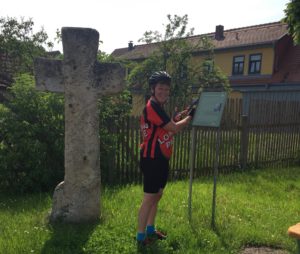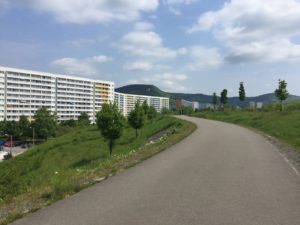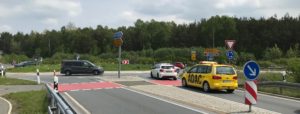In which Sid and Doris ride through the depopulating East of Germany towards Slavic lands.
Some days will have landmark towns en route. Some days will be transport sections. Today was very successful in covering miles from Weimar towards Freiburg and then on to Prague. The names are becoming more Slavic. We paid very close attention to the mapping last night to make today’s climb as road based as possible. This is Saturday and roads have been quiet.
Today’s metrics
Distance: 100 kilometres
Climb: 918 metres
Weather: Pleasant, but a waste of sun screen. Though the amusing cyclists’ tan is coming on well.
Cyclists need constant refuelling. The plan was good but our implementation lacked focus. This area is a bit short of towns to stop in. Our first stop was necessarily early, we did not feel much in need of fuel and failed to stock the metabolic system with buns, opting for a coffee. We paid for this later, topping up on Gummy Bears and an apple. This is not how to haul weight up hillsides.
 At Lobeda, a town without its own horse, we stopped to look at this heavy stone cross. Doris is shown with the translating device reading the sign. This may mark the place where someone was murdered, and so not in a state of grace at time of death. The stone asks you to pray for the unshriven victim. The murderer was never known. We had found a similar stone erected with similar intention in an Essex churchyard on our way to Harwich. It all joins up.
At Lobeda, a town without its own horse, we stopped to look at this heavy stone cross. Doris is shown with the translating device reading the sign. This may mark the place where someone was murdered, and so not in a state of grace at time of death. The stone asks you to pray for the unshriven victim. The murderer was never known. We had found a similar stone erected with similar intention in an Essex churchyard on our way to Harwich. It all joins up.
Today’s petrolhead report has three episodes, this being Saturday a better haul than yesterday. Here I am not counting the aged Ossi farm machinery that at home would be exhibited as antiques at the Essex Young Farmers’ show. First up a pair of Mercedes 450SLs in company with two Beetle convertibles with unusually flat tails. Good effort. Next up around Ruttersdorf a two stroke Stimson motorbike preceding a Trabby cut down to make a Moke-alike device. But the pieces de resistance are the two stroke orchestra. We heard it coming along one of the rattier agri roads maybe a dozen two stroke bikes, and Wartburgs from the ’50s to the 80s just as we saw in the museum at Eisenach. It all joins up most satisfyingly. We heard them coming and smelt them going.
 Our route cunningly skirted Ruttersdorf which presents a very different picture to Altenburg where we now sit outside the magnificent Ratskeller in the elegant town square. The outskirts tell a tougher tale as we cycled past a lot of empty buildings.
Our route cunningly skirted Ruttersdorf which presents a very different picture to Altenburg where we now sit outside the magnificent Ratskeller in the elegant town square. The outskirts tell a tougher tale as we cycled past a lot of empty buildings.
Altenburg is no stranger to bad times. As with much of Central Europe the 30 Years War (over religious differences that Sid finds both incomprehensible and unmemorable) brought fighting and famine. The deaths of about eight million people (Yes 8,000,000) explain unpopulated areas even today. Similar effects can be seen further South from Holy Roman Empire versus Byzantines, an even longer running fixture and still popular today.
Altenburg was prosperous in the mid 19C and was connected by rail to industrial centres. Judging by the agri we have come through it might have been an aggregator and processor. The population here peaked at over 56,000 in the 1980s and is now probably less than 30,000. Get that, not far off half, about the same rate of loss as the 30 years war across large parts of this land. Of course the loss here is mainly to the West rather than the graveyard.
An aging population and no immigration means this will just have to be managed. This is only one example of a phenomenon that will become common as birth rates fall, unless we choose immigration. The European election posters show that there are votes in managed decline, though this is not spelt out. And who will drive the pensioners’ bus? Perhaps it will drive itself.
Never mind, the town still has a brewery and we are enjoying the Schwarz Bier in the square. Dinner beckons, though we have no picture.
[PS I thought you would like a photo of a PROPER cycle-priority roundabout. None of that “cyclists dismount” rubbish here – D.]
